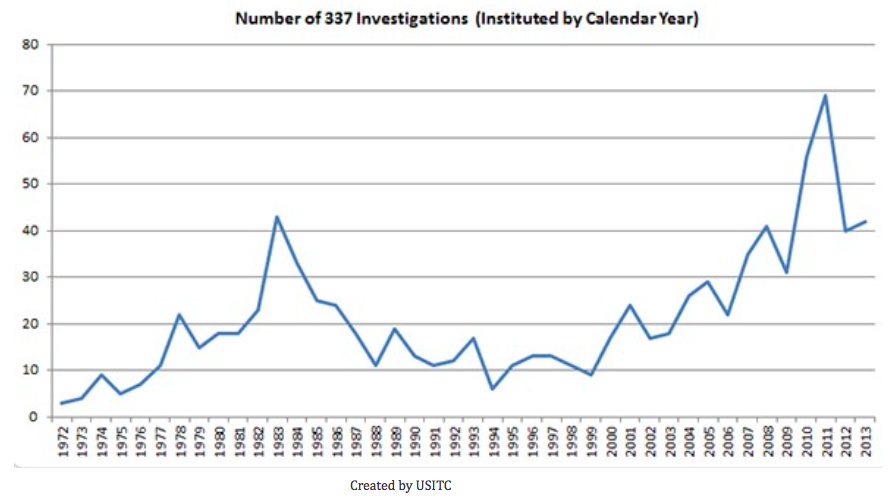When you think of products that may be investigated for unlawful importation into the United States, you probably don’t consider items like barcode scanners, backpack chairs, televisions, and pool enclosures. And yet, all these have already been investigated for unlawful importation just within this year.
For all of these cases, the charges brought were intellectual property infringement.
Section 337 and the ITC
The International Trade Commission (ITC) is the agency responsible for investigating these cases in the U.S. Their work hinges on Section 337 of Title 19, a piece of legislation which prohibits the sale or importation of items which infringe upon a valid and enforceable U.S. patent, copyright, or trademark.
Rising Trends
The ITC’s own records indicate that the number of Section 337 investigations conducted each year has been rising steadily for the past half century:
- Prior to 1977, fewer than 10 investigations were launched per year
- In 1978, there were 22 investigations
- In 1983, the ITC launched 43 Section 337 investigations
- 2011 marked a record high, with 69 investigations

In recent years, computer and telecommunications products have been especially prone to investigation. In 2015, such products accounted for 27% of all Section 337 investigations by the ITC. That’s the same amount as the next three product categories combined.
How Investigations Start
International patent infringement disputes represent almost 90% of Section 337 investigations. The process begins when a U.S. patent holder files a complaint with the ITC, indicating their belief that a Section 337 violation has occurred. Then, the ITC’s Office of Unfair Import Investigations (OUII) reviews the complaint and determines if an investigation is warranted. If the ITC chooses to move forward with one, they publish an official Notice of Investigation in the Federal Register.
Nearly half of all Section 337 investigations result in a trial. On average, these trials take 18 months to resolve.
Language Barriers
ITC litigation is particularly challenging because it involves coordinating with international parties. Predictably, language barriers create difficulties, especially during the initial Discovery phase. Attorneys must review numerous patent documents, many or all of which may be in a foreign language.
As the case progresses, depositions may take place throughout the globe. For the ITC to properly review the necessary materials, all must be translated into English.
To ensure the utmost accuracy, it’s important to seek out professional patent translators attuned to the nuanced language of legal documents. Managing ITC patent litigation generally involves recruiting experts to handle such details.
Case Results
Once all relevant materials have been acquired, prepared, and translated, an ITC judge will review them and hear both sides of the argument. At the completion of litigation, a Notice of Termination is published in the Federal Register. If the judge rules that a Section 337 violation took place, the ITC can take one or both of two remedial orders:
- A cease-and-desist order enforced by the ITC
- An exclusion order enforced by U.S. Customs and Border Protection, barring further importation of the products
Failure to comply with such remedial orders can result in fines costing millions of dollars.

Recent Comments